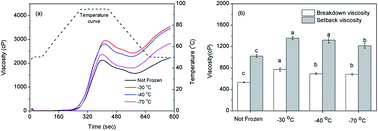Effect of freezing rate on rheological, thermal and structural properties of frozen wheat starch
Abstract
Native wheat starch was frozen at different rates (0.18, 0.37 and 1.54 °C min−1) and then evaluated for dough making. Result showed that damaged starch content was higher in the starch frozen at a slow rate than that frozen at a fast rate. It seemed that a slow freezing rate allowed the formation of ice macrocrystals and affected the integrity of starch granules. The slow freezing rate resulted in a more crystalline and stable structure of double helix for starch, which increased gelatinization temperatures and enthalpy. The pasting behavior was also influenced by the slow freezing rate as indicative of a significant increase (p < 0.05) in breakdown and setback values. Farinograph test was performed in reconstituted dough by using wheat starch–gluten mixtures as model systems. Water absorption, dough development and stability were affected in samples with starch frozen at a slow rate. The dough frozen at slow rate displayed the lowest bread and the hardest crumb while rapid freezing resulted in a less structural and functional changes in starch.


 Please wait while we load your content...
Please wait while we load your content...